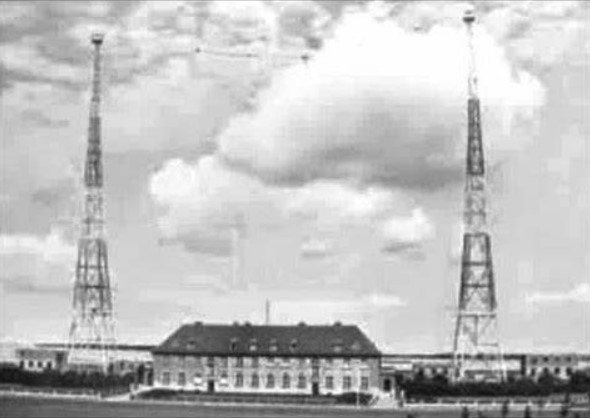 German Radio Station Gleiwitz in 1936.
German Radio Station Gleiwitz in 1936.
 German Radio Station Gleiwitz in 1936.
German Radio Station Gleiwitz in 1936.
Robert H. Jackson, a U.S. Supreme Court Justice from 1941 to 1954, was sent to Europe when the war was ending to make sure that Germany alone would be blamed for the Second World War. Jackson, as leader of the U.S. legal team, helped draft the London Charter of the International Military Tribunal, which created the legal basis for the Nuremberg Trials.
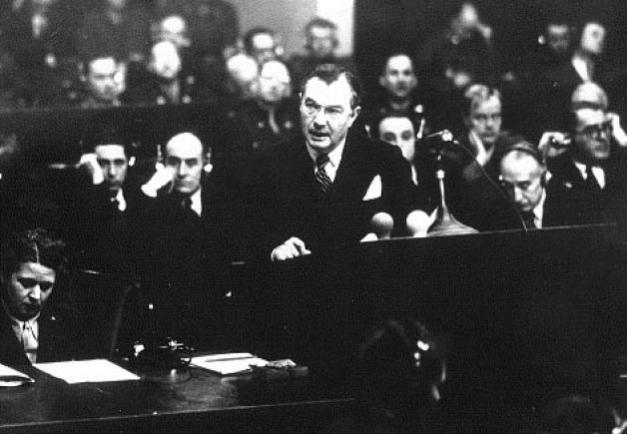 Above: Chief Prosecutor for the United States Robert Jackson at Nuremberg making an aggressive case against the "Nazis."
Above: Chief Prosecutor for the United States Robert Jackson at Nuremberg making an aggressive case against the "Nazis."
After studying some of the documents, Jackson knew well and emphasized that the German declaration of war on the United States was perfectly legal. Therefore, he pointed out, it had to be shown before the court that the war in Europe was, from the beginning, a German aggression contrary to international law (making it a Crime Against Peace). Thus, the invasion of Poland had to be shown to be an aggressive move with no justification, and no blame on Poland. Further study of the files brought Jackson to doubt that a fair trial would support, in any way, the finding of Germany’s exclusive responsibility. On the contrary, he said:
“The Germans will certainly accuse our three European allies to have pursued a policy that has enforced the war. I say this because the seized documents from the German Foreign Office, which I have seen, all come to the same conclusion: “We have no escape, we must fight, we are surrounded, we are strangled.” How would a judge react if this is found in the trial? I think he would say: “Before I condemn anyone as the aggressor, he ought to describe his motives.”
And that would be catastrophic, Jackson continued, because
“… if this trial leads to a discussion of the political and economic causes of the war, this may cause infinite damage, both in Europe I do not know well, and in America that I know fairly well.”
As a servant of the U.S. Government and U.S. war policy, Jackson came up with the only solution: to ban any discussion on the causes of the war before the Nuremberg tribunal. In other words, not to have a fair trial. In the transcripts of the proceedings, nothing is found on the war policies of the West, Poland, or the USSR since almost all documents and testimonies that would have been relevant in this respect were rejected by the court as irrelevant.
But affidavits like the one signed by Alfred Naujocks, in which he claimed, without any corroboration, that he participated in a German undercover operation on the very night that Hitler ordered the invasion of Poland, the purpose of which was to attack the Gleiwitz radio station and blame it on the Poles in order to justify Germany's “crime against peace” — this affidavit was admitted by the court with no questions or discussion. Naujocks did not appear in person, only his affidavit was put in evidence; there was no opportunity for cross-examination of the witness by the defense.
In such a way did the “evidence” accumulate to find Germany's National Socialist government guilty of “Crimes Against Peace.”
Jackson was appointed to federal office by President Franklin Delano Roosevelt in 1934, serving initially as general counsel of the U.S. Treasury Department's Bureau of Internal Revenue (today's Internal Revenue Service), then as Assistant Attorney General heading the Tax Division of the Department of Justice. In 1937 he became Assistant Attorney General heading the Antitrust Division. In 1938, Jackson became United States Solicitor General, serving until January 1940 as the government's chief advocate before the Supreme Court.
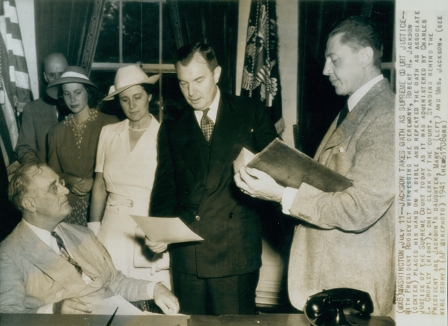 Above: Robert Jackson (center in dark suit) takes the oath of office as an Associate Justice of the Supreme Court in 1941, witnessed by Pres. Franklin Roosevelt (seated), apparently in the Oval Office.
Above: Robert Jackson (center in dark suit) takes the oath of office as an Associate Justice of the Supreme Court in 1941, witnessed by Pres. Franklin Roosevelt (seated), apparently in the Oval Office.
Jackson was a supporter of the New Deal and of Roosevelt, who regarded him as a potential heir — in 1937 Roosevelt considered having him run for Governor of New York. Jackson was a fellow Democrat, fellow country squire, and fellow Dutch-American.
Roosevelt appointed Jackson to the Supreme Court in 1941, even though he didn’t have a law degree. In 1943, in keeping with the liberal policies of Roosevelt’s “stacked court,” Jackson wrote the majority opinion (based on individual rights) which overturned a West Virginia public school regulation that made it mandatory to salute the flag and imposed penalties upon students who failed to comply.
After the war, in 1954, Jackson played a major role in the Brown vs. Board of Education decision. While it was being considered, Jackson wrote a draft memorandum titled “CHANGED CONDITIONS” in which he stated that prior to Brown, segregation was legal … but that the premise for overruling the separate but equal doctrine was that he now recognized as erroneous the "factual assumption" that "there were differences between the Negro and the white races, viewed as a whole." So, while Jackson could not justify the decision made in Brown in law, he did so on the basis of a “political and social imperative.” (He used the same political and social imperative rather than law to underpin decisions made at the Nuremberg IMT.)
During the deliberations on Brown in 1954, Jackson was hospitalized. Chief Justice Earl Warren visited him several times to discuss the Brown decision, and took from Part 4 of Jackson’s draft opinion this line: “Negroes have achieved outstanding success in the arts and sciences as well as in the business and professional world.” On May 17, 1954, Jackson went to the Court from the hospital so there would be a full court present on the day Brown was handed down as a unanimous decision. Jackson died in October, 1954.
A communication was sent from the chief of police in Gleiwitz on the night of August 31 that the radio station was assaulted by irregular Polish troops who, for a short time, succeeded in occupying the station before being chased out by the German Frontier Police. During their defense [of the station] one Polish irregular was mortally wounded and left behind.
Another communication came from a representative of the town of Troppau about the customs house of Hohenlinde. In the night of August 31, it was attacked by Polish irregulars who succeeded in occupying it; but thanks to a counterattack by Waffen-SS auxiliary troops, the irregulars were routed.
If true, this means that the first two war crimes of WWII were committed by the Poles! First, by making incursions into German territory when a declared state of war did not exist. Second, by using irregular, non-uniformed troops (as doing so invites attacks on any suspicious civilians).
In the official German documents about the border raids, there are mentioned fully 44 acts of Polish aggression over the six days and nights before the German invasion (which began around 4 a.m. on September 1st). On the night of August 31st, there were reportedly 14 incidents of provocation by Polish irregulars of which Gleiwitz and Troppau were but two. In this text, it is clearly stated that the attackers did not wear Polish uniforms, but that they were irregular troops, based in Hohenlinde and in Gleiwitz. And finally, according to the German documents detailing Polish prewar attacks, the post of Hohenlinde was not burned (as stated by H. S. Hegner) but merely occupied.
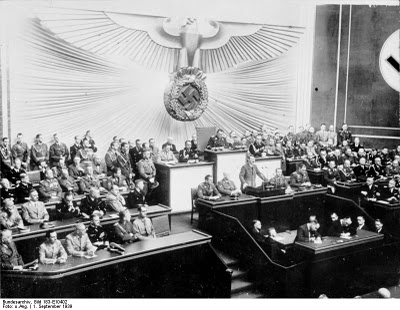
In his speech to the nation on Sept. 1, 1939 (pictured above), Adolf Hitler did not mention, except indirectly, this so-important Gleiwitz “false flag” that was supposedly ordered by him to justify his invasion order, but instead spoke at length about the ongoing provocations over the past four months by the Poles. He pointed out that since 1919-1920, 100,000 ethnic Germans who were Polish citizens had been forced to flee their homes in Poland.
He had only this to say about what occurred during the previous night:
These proposals for mediation have failed because in the meanwhile there, first of all, came as an answer the sudden Polish general mobilization (Aug. 30), followed by more Polish atrocities. These were again repeated last night (Aug. 31). Recently in one night there were as many as twenty-one frontier incidents; last night there were fourteen, of which three were quite serious. I have, therefore, resolved to speak to Poland in the same language that Poland for months past has used toward us. This attitude on the part of the Reich will not change.Further on in his speech, Hitler said...
This night for the first time Polish regular soldiers fired on our territory. Since 5:45 A.M. we have been returning the fire, and from now on bombs will be met by bombs.
Fire coming across the border from Polish regular soldiers does not mean a raid on a radio station by irregulars. The raid on the Gleiwitz station and the customs house in Hohenlinde must be included in the “three which were quite serious.” But is that how a leader makes use of a “false flag” event that he ordered, intending to use as a pretext? No.
The words “Gleiwitz” or “radio station” never came up in the speech, nor afterward from Hitler. So much for it being a German “false flag” from the German perspective!
Let me remind you that when U.S. President Roosevelt carefully created his pretext for war—the bombing of Pearl Harbor by the Japanese — he played it up for all it was worth to Congress the next day. That's what false flags are for. Roosevelt opened his speech by saying:
Yesterday, December 7th, 1941 -- a date which will live in infamy -- the United States of America was suddenly and deliberately attacked by naval and air forces of the Empire of Japan.
The United States was at peace with that nation and, at the solicitation of Japan, was still in conversation with its government and its emperor looking toward the maintenance of peace in the Pacific.
He described the attack in detail, rallied the citizens, and ended with:
I ask that the Congress declare that since the unprovoked and dastardly attack by Japan on Sunday, December 7th, 1941, a state of war has existed between the United States and the Japanese empire.
That's how it is done.
The only “evidence” for the Gleiwitz radio station attack as a German false flag operation consists of the uncorroborated "confession" (only a signed statement) in 1945 of a German SS officer, Alfred Naujocks, who was then in the hands of the Allies. Here is the affidavit taken from the transcript of the tribunal.
COL. STOREY:
I now offer in evidence Document 2751-PS, which is Exhibit USA-482. It is an affidavit of Alfred Helmut Naujocks, dated November 20, 1945. This affidavit particularly refers to the actual occurrences in connection with the Polish border incident. I believe it was referred to by the Witness Lahousen when he was on the stand:
“I, Alfred Helmut Naujocks, being first duly sworn, depose and state as follows:
- I was a member of the SS from 1931 to 19 October 1944 and a member of the SD [Sicherheitsdienst: SS Security Service] from its creation in 1934 to January 1941. I served as a member of the Waffen-SS from February 1941 until the middle of 1942. Later I served in the Economics Department of the Military Administration of Belgium from September 1942 to September 1944. I surrendered to the Allies on 19 October 1944.
- On or about 10 August 1939 the Chief of the Sipo and SD, Heydrich, personally ordered me to simulate an attack on the radio station near Gleiwitz, near the Polish border, and to make it appear that the attacking force consisted of Poles. Heydrich said: ‘Actual proof of these attacks of the Poles is needed for the foreign press, as well as for German propaganda purposes.’ I was directed to go to Gleiwitz with five or six SD men and wait there until I received a code word from Heydrich indicating that the attack should take place.
My instructions were to seize the radio station and to hold it long enough to permit a Polish-speaking German, who would be put at my disposal, to broadcast a speech in Polish. Heydrich told me that this speech should state that the time had come for the conflict between the Germans and the Poles and that the Poles should get together and strike down any Germans from whom they met resistance. Heydrich also told me at this time that he expected an attack on Poland by Germany in a few days.
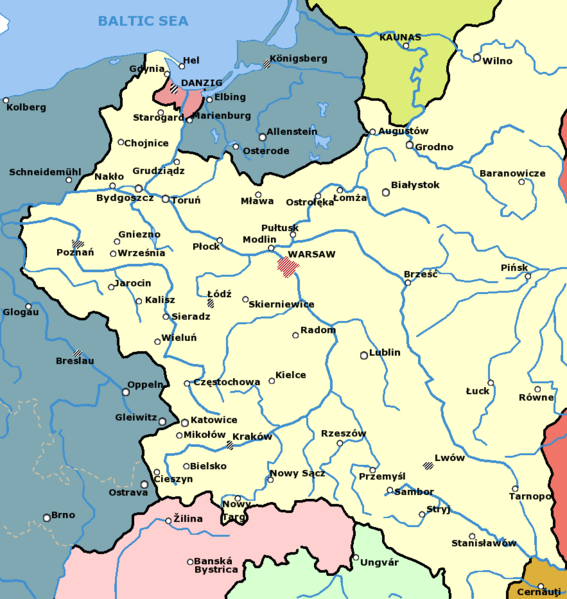 Map of German-Polish frontier in 1939.
Map of German-Polish frontier in 1939.
And then “sworn to and subscribed to before Lieutenant Martin”.
- I went to Gleiwitz and waited there a fortnight. Then I requested permission of Heydrich to return to Berlin but was told to stay in Gleiwitz. Between the 25th and 31st of August I went to see Heinrich Müller, head of the Gestapo, who was then nearby at Oppeln. In my presence Müller discussed with a man named Mehlhorn plans for another border incident, in which it should be made to appear that Polish soldiers were attacking German troops--Germans in the approximate strength of a company were to be used. Müller stated that he had 12 or 13 condemned criminals who were to be dressed in Polish uniforms and left dead on the ground at the scene of the incident to show that they had been killed while attacking. For this purpose they were to be given fatal injections by a doctor employed by Heydrich. Then they were also to be given gunshot wounds. After the assault members of the press and other persons were to be taken to the spot of the incident. A police report was subsequently to be prepared.
- Müller told me that he had an order from Heydrich to make one of those criminals available to me for the action at Gleiwitz. The code name by which he referred to these criminals was ‘Canned Goods.’
- The incident at Gleiwitz in which I participated was carried out on the evening preceding the German attack on Poland. As I recall, war broke out on the 1st of September 1939. At noon on the 31st of August I received by telephone from Heydrich the code word for the attack which was to take place at 8 o’clock that evening. Heydrich said, ‘In order to carry out this attack, report to Müller for “Canned Goods.”‘ I did this and gave Müller instructions to deliver the man near the radio station. I received this man and had him laid down at the entrance to the station. He was alive, but he was completely unconscious. I tried to open his eyes. I could not recognize by his eyes that he was alive, only by his breathing. I did not see the shot wounds, but a lot of blood was smeared across his face. He was in civilian clothes.
- We seized the radio station as ordered, broadcast a speech of 3 to 4 minutes over an emergency transmitter, fired some pistol shots, and left.”
Note that the simulated attack on the radio station is ordered already on August 10, whereas the Ribbentropp-Molotov pact was not signed until the 26th of August. It seems the prosecutors are wanting to show that it was pre-planned in order to emphasize the criminal nature of it. Heydrich tells Naujocks that the purpose is to create something for German propaganda and for the foreign press — but was it used for that? No.
Who were the five or six SD men who accompanied him? Why aren't they named? Pointing out that a Polish-speaking German was going to be put at his disposal to broadcast the message over the radio transmitter seems an unnecessary apendage.
After two weeks of waiting, Naujocks goes to see Gestapo chief Heinrich Müller and hears a discussion with a man named Mehlhorn about another planned incident in which it should be made to appear that Polish soldiers were attacking German troops. Twelve or thirteen condemned criminals were to be dressed in Polish uniforms and left dead on the ground. But rather than just shooting them, they were to be given “fatal injections” by a doctor employed by Heydrich, and then given gunshot wounds. Afterwards, members of the press were to be taken to the spot and shown the dead bodies. Do we have any press reports of this? No.
Müller told Naujocks he had been ordered by Heydrich to make one of those condemned criminals available to him for Gleiwitz. On the 31st of August, Naujocks reported to Mueller again and requested his one “dead man” be delivered near to the radio station. The man who was delivered was still alive, but unconscious. Naujocks saw no gunshot wounds on the man and he, Naujocks, did not shoot him. But also, this man was not wearing a Polish uniform as previously determined, but was dressed in civilian clothes!
He then said “they” (wearing Polish uniforms?) broadcast a message of 3 to 4 minutes over the emergency transmitter… fired some shots, and left.
Identical to Holocaust survivor stories that had to be partially dreamed up by Nuremberg prosecutors (even to the “fatal injections” by Nazi doctors), this story doesn't hold together and doesn't sound like the kind of plan intelligent Germans would come up with. As pointed out above, it was totally unnecessary. It was only of value to the Nuremberg prosecutors who needed some believable German aggression against Poland for their “Crimes against Peace” charge.
But the Nuremberg prosecutors were accusing the SD of carrying out a crime against peace by staging so-called border incidents before the outbreak of the [German-Polish] war to give Hitler an excuse for starting the war. However, as the defense for the SD showed, nothing of the sort was carried out by the pertinent departments (Amt. III and VI). Naujocks explained this away by saying it was a personal request made to him by Reinhard Heydrich. No one in the appropriate SD departments had any knowledge of such an operation.
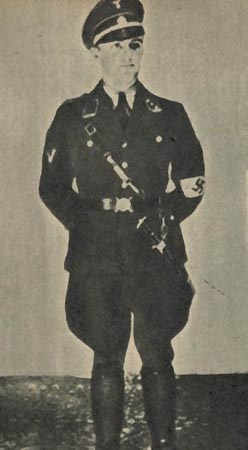
Born in Kiel in 1911, where he studied engineering. As is said in the affidavit, he became a member of the SS in 1931, and the SD in 1934. In 1941, with the rank of SS Sturmbannfuehrer, he was dismissed from the SD after disputing one of Reinhard Heydrich's orders. He was demoted and had to serve in the Waffen-SS on the Eastern Front. In 1943, due to his health, he was sent to the West, where he served as an economic administrator for the troops in Belgium. These experiences may have soured him and made him want to look after himself first when the opportunity arose. Because, in October of 1944 Naujocks surrendered or “deserted” — turned himself over to U.S. forces — who placed him in detention as a possible war criminal. He is said to have “escaped custody” after the war, but he signed the Nuremberg affidavit on November 20, 1945, the day before testimony at the war crimes trial started. Was he in custody at that time, and was he released following the carrying out of that service for the United States prosecutors?
Naujocks turned up later as a businessman in Hamburg operating under his own name, and later sold his story to a newspaper, under the title “The Man Who Started The War.” All this occurred very much in the open. He died of a heart attack in 1966 in Hamburg without ever being interviewed by a historian. Strange.
The writer H.S. Hegner, aka Harry Wilde, included an account of the Gleiwitz incident from the Polish/Jewish propaganda point of view in his book Die Reichskanzlei 1933-1945. Since no one else has done so, (realize that there exists no official version with respect to this subject — not in the French Yellow Book [of diplomatic documents] about the war, nor in Churchill's Memoirs) Hegner's has become the most widely quoted reference for Gleiwitz, in spite of the fact that it differs in important ways from the Naujocks affidavit.
A summary of Hegner's version was included in Spanish revisionist Joachin Bochaca's Los Crimenes de los “Buenos” (The Crimes of the “Good Guys”), 1982, quoted below.
Heinrich Mueller, a high functionary in the Gestapo, had been tasked (by someone, perhaps Hitler) with concocting an official motive for Germany's declaring war on Poland. A hundred prisoners from German concentration camps were taken to the city of Oppeln, next to the Polish frontier. These men were put into German SS uniforms and posted near the frontier. There they were surprise-attacked by German soldiers dressed in turn in Polish uniforms, who pounced on the poor prisoners--the faux SS--and murdered them. That was part one.
Once this was done, the Germans in their Polish uniforms next headed toward the Polish frontier and, in passing, occupied and burned their own German customs post in Hohenlinde. Next, an alleged agent of the Gestapo named Naujocks, in command of German soldiers disguised as members of a Polish patriotic paramilitary organization--a detail that Hegner omits to mention--attacked the German radio station in Gleiwitz.
In the Gleiwitz operation there was only one fatality, which Mueller conveniently took care of. It was of a prisoner wearing a Polish military uniform, who had been rendered unconscious by an injection and was afterwards executed in the course of the action.
Differences between Hegner and Naujocks:
This is all reminiscent of rumors and stories that are passed around — the details change in ways that make it something quite different. Downright lies are also added to make it a more interesting or more useful story for the teller. Since there is no official record to go by, it becomes “anything goes” — and what is found on the Internet proves that out. The "Gleiwitz False Flag" is a fabrication invented for Nuremberg and there is nothing more to it than that.
Harry Paul Schulze was born on July 16, 1899 in Zwickau, to Clara Hegner and Paul Schulze, a butcher. He became a journalist and author under the pseudonyms Harry Schulze-Wilde, Harry Schulze-Hegner and H.S. Hegner.
In his youth he apprenticed as a businessman, but in the1920's he went on his own as a city tour guide in Erfurt and Weimar. He became involved in the German leftist youth movement, becoming a member of German Labor Youth. He then became involved with the Christian Revolutionaries under the leadership of the leftist, Pleivier. Schulze was a member of the communist party until 1932. In 1933, the Hitler government jailed him for suspicious activity.
He managed to run away to Dresden, where he had an aunt; then, pretending to be a representative for a publisher, made his way to Prague. There he met Comintern representatives Willi Muenzenberg and Johannes Becher. They sent him to Amsterdam to check out the story of Marinus van der Lubbe, who was found guilty of starting the Reichstag Fire, which occurred in February 1933.
In Amsterdam Hegner-Schulze became close friends with Dutchman Jef Last, and together they wrote a book about von der Lubbe, which came out in 1939. Their friendship was of a nature that indicated a homosexual relationship. After the war, Hegner-Schulze wrote a book about National Socialism against homosexuality with the title (in English): The Fate of the Dammed. Wilde also lived in France, Belgium and Luxembourg, before fleeing to Switzerland in 1942.
After the war — He founded a magazine in 1947 in Munich called (in English) Echo of the Week. He also wrote biographies for the publishing house Rowohlt, under the name Harry Wilde, including a monograph about Walther Rathenau, the German-Jewish diplomat of the Weimar regime. What he wrote suggested suppressed homosexual desires in Rathenau. In 1959 his book Die Reichskanzlei 1933-1945 came out in Germany. As best I can gather, this is where his account of the Gleiwitz incident first appeared. Later he wrote books on Rosa Luxemburg and Leon (Lev) Trotsky.
From this point on, Hegner led a secluded private life with his daughter, Cordelia, while at the same time he had a boyfriend, Joachim Klose. He is categorized as a historical journalist … heavy on the "stori" part. One critic stated: “Where the real history ends, and where the stories of the author Hegner, alias Schulze-Wilde, begins, no reader can tell.”
Where are pictures of the dead man found at the radio station? The National Socialists would surely have photographed the scene to document the “Polish crime.” Where are the newspaper headlines and the newsreels that are said to have been produced for the same purpose? Every false flag operation has to have these. Gunther Kumel has stated that neither Hitler, nor Goebbels, nor any other official made use of the Gleiwitz incident to vindicate the attack on Poland.
The Gleiwitz incident, in which a gang of Polish irregulars occupied a German radio station on the frontier before being chased away, could not have triggered the German invasion of Poland a few hours later. By March 1939, Polish atrocities against the German minority had reached peaks unknown before. Ethnic Germans were fleeing into the woods to prevent being murdered. Seventy thousand reached Germany and were placed in camps. How many others fled to friends and relatives? The number is not known. As Germans crossed the border, the Polish Military shot at them with live ammunition, killing many. Polish artillery shot at German civilian aircraft heading for East Prussia. The Poles had prepared lists of all ethnic Germans and started to kill them in the first days of September (Bloody Sunday is an example).
Since everyone in Germany and Europe knew these facts, there was no need for an additional faked provocation. What was necessary for the Allies at Nuremberg, however, was a way to bury the Polish provocations that were aimed at forcing Germany to attack. Turning all the Polish aggressive acts against ethnic German citizens of Poland into “false flags” that were then blamed on Germany to fool the world, is the solution they came up with. Since the victors were then in total control, they had no trouble pushing through anything they wished. They are still in control and still keeping this unsupported rumour in place.
The real aggressor was Poland, and it's guarantors in case of war with Germany — France and England. Those three are the nations truly guilty of “crimes against peace.”